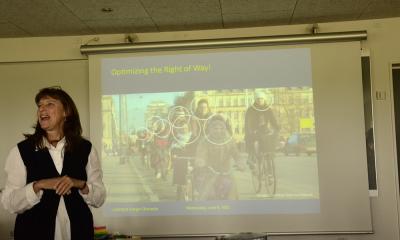We've all clearly had a good time in Copenhagen. We’ve listened to excellent lecturers from government, industry, academia and the nonprofit sector. We've studied intersections, routes and neighborhoods. We've scrambled around the region in teams on a multimodal scavenger hunt. And we've spent time getting to know each other and sharing perspectives over drinks and dinner.
But why did this group of electeds, practitioners, architects and advocates spend a week in Copenhagen with I-Sustain, many through the support of the Scan/Design Foundation? Wouldn’t it have been cheaper and easier to block off a Friday, order lunch and book a conference room?

Nancy Rottle, a professor at the UW in landscape architecture, kicks off the design charrette
Well, not really. As I’ve described in a previous post, it was essential to immerse ourselves in the actual experience. That said, this trip is only as useful as what we’ll all do together afterward.
To get us moving in that direction, we dedicated yesterday afternoon to a design charrette. The basics: we split into three groups of five and took on three separate design tasks specific to the context of Seattle. One group approached the task of planning and designing a vision for bicycle routes from one neighborhood to another. The second looked at planning and designing nonmotorized movement and stormwater management inside one neighborhood. The third group took on one distinct intersection and how to make it work for bikes, pedestrians and stormwater.
After we had some fun, unrestrained visioning, as part of the exercise we all considered necessary policy changes and resource needs to ground us a little in reality. Oh yeah—this or that costs money. And oh yeah—this or that would currently be illegal.

Designing better streets for bikes and pedestrians
What came out of it, aside from sheets of very specific hand-drawn overlays, colored maps and a list of policy directions?
I’m sure there are many other lessons that the group came away with, but I learned three main things:
- That my colleagues are brilliant and that we’ve needed to have this type of conversation with this particular group for a good while.
- That the funding and policy barriers are real—but that the vision is compelling enough for those barriers to be surmountable.
- That we’re ready to import a boat-load of new concepts, lessons learned and our collective ideas from the design charrette and innumerable side conversations.
So as I pen this from the Copenhagen airport, I’m sad to call an end to the trip—riding among a sea of people at rush hour, learning from experts in one of the world’s best cities for bicycling, taking in the livable, vibrant urban environment that bicycling has helped to create. Yet I’m also tremendously excited to return—to build on the charrette and all we’ve learned and get to work re-imagining the Seattle region’s experience.

Taking on tough connections between neighborhoods
Share this post
